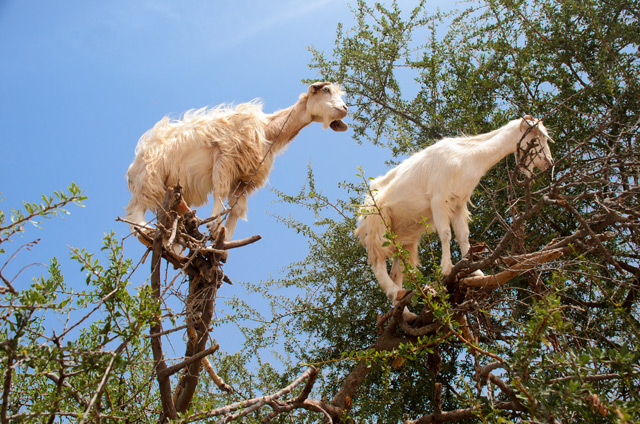Tree-climbing goats help sow new forests by SPITTING out the seeds, scientific study shows
08/25/2018 / By Bridgette Wilcox

The forests of morocco have found an unexpected ally: tree-climbing goats. A new study has found that the limber creatures have been inadvertently planting trees and rebuilding forests by spitting out the nuts from the argan fruits they forage on.
The research, published in Frontiers in Ecology and the Environment, observed the foraging behavior of domestic goats in arid southwest Morocco. The goats are known to climb trees up to 30 feet high, especially during the autumn season, when vegetation is scarce. Throughout the season, goats spend 74 percent of their foraging time grazing through the tops of argan trees, eating the trees’ fruit. They then chew and swallow the fruit, and the large seeds remain in their rumen — one of four chambers in the stomachs of animals such as goats and cows. The seed is then regurgitated along with the cud, and then spit out by the goats.
Through the whole process, they become part of endozoochory, a seed dispersal mechanism done through animals, during which seeds are ingested, pass through the digestive system, and are usually defecated afterwards. The researchers confirmed that Moroccan tree-climbing goats disperse argan seeds not through defecation, but through regurgitation — mostly because these particular seeds are larger than usual.
The seed-spitting behavior of Morocco’s tree-climbing goats is a variation on the typical endozoochory, since the seeds in this case do not pass through the animals’ lower digestive tract. This “largely overlooked form of endozoochory,” benefits plants in many ways — for instance, seeds dispersed far from their maternal plant have a greater probability of survival. In this case, because the seeds are carried in goats’ stomachs sometime before they are spit out, it takes the seeds further away from its mother plant, making them more likely to survive.
Evidently, tree-climbing goats are an important part of the ecosystem of southern Morocco’s argan forests, which are “ecologically and economically important” in the region, according to the study. Not only do the nuts they disperse promote the growth of new trees, but are also collected by farmers who produce argan oil, an edible oil used in everything from Moroccan cuisine, to luxurious cosmetics.
While often demonized for destroying landscapes and eating every plant in sight, goats can actually be very helpful when it comes to farming and reforestation. For instance, at Zaytuna Farm, a permaculture training site in New South Wales, Australia, has involved goats in their effort to clear weed-tree-infested areas for reforestation, according to an article on PermaCultureNews.org.
The reforesters converted a car trailer into a mobile goat shelter and fenced goats in to a 2,500 sqm. area containing 60 percent pasture and 40 percent weed-tree-infested forest edge. As they searched for food, the goats ended up eating parts of the weed trees that they could reach. Eventually the farmers cut down the taller weed trees for them to forage. Making the weed trees more available to the goats kept them away from the quality trees that are within their area.
Once the weeds were reduced to a stump by the goats, the farmers hacked at their root systems to inhibit re-sprouting. The entire cycle was repeated until the weed stumps become so weak that they begin to die. The goats, which by way of digestion converted the weed trees into manure for fertilization, paved the way for the reforestation of the farm with high quality trees, proving that goats can be instrumental in creating new forests.
Read more articles about tree-climbing goats at GreenLivingNews.com.
Sources include:
Tagged Under: agriculture, animals, argan oil, domestic goats, Ecology, ecosystem, endozoochory, environment, foraging behavior, forests, goats, reforestation, seeds, weird science




















